|
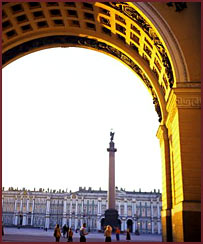 From
the 1760s the Winter Palace was the main residence of the
Russian Tzars. From
the 1760s the Winter Palace was the main residence of the
Russian Tzars.
Magnificently located on the bank of the Neva River,
this Baroque-style palace is perhaps the major attraction
of St. Petersburg.
Many visitors also know it as the main building of
the Hermitage Museum (which consists of six buildings). The
green-and-white three-storey palace is truly impressive: it
has 1786 doors, 1945 windows and 1057 halls and rooms, many
of which are open to the public.
The Baroque Winter Palace was built in 1754-62 for
Empress Elisabeth, daughter of Peter
the Great. By the time it was completed Elisabeth had
already died, and only Catherine the Great and her successors
could enjoy their new home.
|
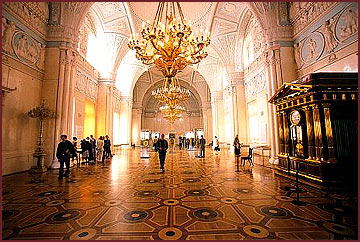
Interior of the Winter Palace.
The Shadow of the Winter Palace recounts an extraordinary
century of Russian history, a politically tempestuous time that
was also a Golden Age of intellectual and artistic achievement-the
century of Dostoevsky and Tolstoy,
of Rimsky-Korsakov and Tchaikovsky. During Revolution
it was the scene of many demonstrations and then was used as
a hospital.
|
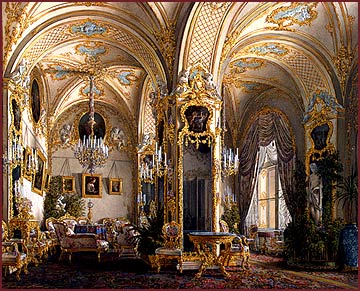
Interiors of the Winter Palace. The
Drawing Room in Rococo II Style, with Cupids , Watercolour,
Edward Hau, 1860s.
It is in the old Winter Palace (1754-1764, work of Rastrelli)
that the greatest artistic masterpieces are presented under
the name of Museum of the Hermitage. This old palace is of style
baroque, on three floors. The Museum of the Hermitage, first
museum of Russia, shelters 2 700 000 works of art including
67 000 exposed in 400 rooms.
|
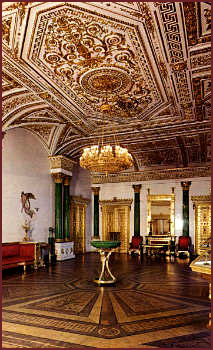 Many
of the impressive interiors have been remodeled since then,
particularly after 1837, when a huge fire destroyed most of
the palace. Many
of the impressive interiors have been remodeled since then,
particularly after 1837, when a huge fire destroyed most of
the palace.
Nowdays the Winter Palace, together with four more
buildings houses the extensive collections of the Hermitage.
The Hermitage Museum is the largest art gallery in Russia
and is among the largest and most respected art museums in
the world.
|
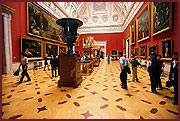 The
present structure, completed in 1762 and designed by Bartolomeo
Rastrelli, was commissioned by the Empress Elizabeth. Its opulent
baroque facade, stretching two hundred meters, is a veritable
cornucopia of pilasters, bays, and statuary. The
present structure, completed in 1762 and designed by Bartolomeo
Rastrelli, was commissioned by the Empress Elizabeth. Its opulent
baroque facade, stretching two hundred meters, is a veritable
cornucopia of pilasters, bays, and statuary.
|
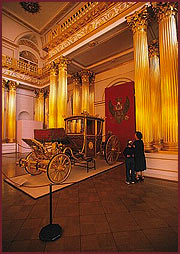 The palace served as the winter residence for every ruler
of Russia since Peter I, who installed
himself there along with his mistress, the Countess Vorontsova.
The palace served as the winter residence for every ruler
of Russia since Peter I, who installed
himself there along with his mistress, the Countess Vorontsova.
After his wife Catherine the Great seized the throne,
she redecorated and appropriated her husband's old quarters.
While her son Nicholas I lived in a modest apartment there,
his wife Alexandra commissioned the famously luxurious Malachite
Room, later to be used as the meeting place for Kerensky's Provisional
Government.
Nicholas II had his quarters immediately above this room
until 1904, when he moved from the increasingly discontented
capital to Tsarskoe Selo. In July of 1917, the Provisional Government
took up residence here, thus setting the stage for the October
Revolution. After consolidating its power, the Bolshevik government
transferred its capital to Moscow, and since that time the Winter
Palace has been associated primarily with its role as the Hermitage
Museum.
|
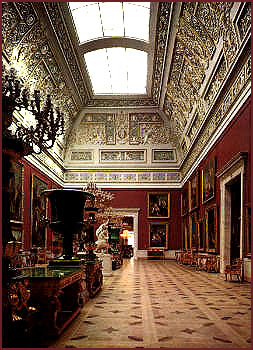
|
 In
the middle of the Palace Square is the Alexander Column erected
in 1830-1834 after a design by Auguste Montferrand. Both the
Column and the General Staff Arch commemorate the Russian victory
over Napoleon in the 1812-1814 war. In
the middle of the Palace Square is the Alexander Column erected
in 1830-1834 after a design by Auguste Montferrand. Both the
Column and the General Staff Arch commemorate the Russian victory
over Napoleon in the 1812-1814 war.
The Column is hewn from a cliff that was found in a bay
in the Gulf of Finland. The 230-ton monolith was carved away
by hand for three years and then brought to St.Petersburg in
a barge built specially for that purpose. Two thousand soldiers
rolled it onto a high pedestal with the help of a very intricate
system. It is not attached to the pedestal but is securely held
in place by its huge weight.
The figure of an angel on top symbolizes the peace that
settled on Europe after the victory over Napoleon. Rising to
a height of 47.5 metres the Column outshines the Trojan Column
in Rome and the Vendome Column in Paris.
|
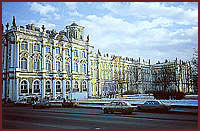 Palace
Square has witnessed many historical events. It was the scene
of the "Bloody Sunday" massacre. And it was from this
place that revolutionary soldiers and sailors stormed the Winter
Palace on an autumn night in 1917. The cobblestones in the middle
of the square have been pre-served as they were in October 1917
as a reminder of that historic event. On national holidays,
demonstrations are held in Palace Square. All through the year
it is packed with tourist buses. Palace
Square has witnessed many historical events. It was the scene
of the "Bloody Sunday" massacre. And it was from this
place that revolutionary soldiers and sailors stormed the Winter
Palace on an autumn night in 1917. The cobblestones in the middle
of the square have been pre-served as they were in October 1917
as a reminder of that historic event. On national holidays,
demonstrations are held in Palace Square. All through the year
it is packed with tourist buses.

|
 |
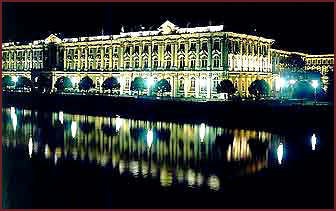 |
| Winter
Palace at night (from Dvortsovy Bridge). |

|
The
Hermitage museum.
With the possible exception of the Louvre, there is no
museum in the world that rivals the Hermitage in size and quality.
Its collection is so large that it would take years to view
it in its entirety - at last count, there were nearly three
million works on exhibit.
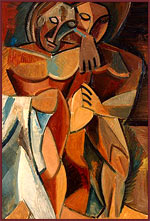 The
total length of the Hermitage routes is over 20 km. It would
take one over a hundred years to cast if only a cursory glance
at each object of the Hermitage. The
total length of the Hermitage routes is over 20 km. It would
take one over a hundred years to cast if only a cursory glance
at each object of the Hermitage.
Every year 400 exhibition rooms receive three and a half
million visitors. The Hermitage now possesses 15,000 paintings,
12,000 sculptures, 600,000 drawings, 600,000 archaeological
finds, 224,000 objects of applied art, a million coins and medals,
etc.
The museum is especially strong in Italian Renaissance
and French Impressionist paintings, as well as possessing outstanding
collections of works by Rembrandt, Picasso, and Matisse. Not
least among the attractions of the Hermitage is the museum itself,
with its fine interior decoration and architectural detail.
|
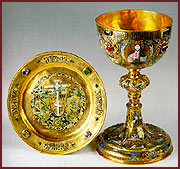 The
collection of the Department of Russian Culture consists of
over 300,000 items and reflects a thousand-year Russian history.
Icons and articles of artistic handicraft represent the inner
world and way of life of ancient Rus. The items of Peter
the Great's time illustrate the epoch of important transformations. The
collection of the Department of Russian Culture consists of
over 300,000 items and reflects a thousand-year Russian history.
Icons and articles of artistic handicraft represent the inner
world and way of life of ancient Rus. The items of Peter
the Great's time illustrate the epoch of important transformations.
|
|
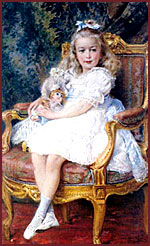 The
origins of the Hermitage can be traced back to the private
art collection of Peter the Great,
who purchased numerous works during his travels abroad and
later hung them in his residence. Catherine the Great expanded
the collection considerably, and she and her successors built
the Hermitage collection in large part with purchases of the
private collections of the Western European aristocracy and
monarchy. By the time Nicholas II
ascended the throne in 1894, he was heir to the greatest collection
of art in Europe. The
origins of the Hermitage can be traced back to the private
art collection of Peter the Great,
who purchased numerous works during his travels abroad and
later hung them in his residence. Catherine the Great expanded
the collection considerably, and she and her successors built
the Hermitage collection in large part with purchases of the
private collections of the Western European aristocracy and
monarchy. By the time Nicholas II
ascended the throne in 1894, he was heir to the greatest collection
of art in Europe.
After the Revolution of 1917, the museum was opened
to the public, and its collection was further augmented by
the addition of modern works taken from private collections.
Today, the Hermitage has embarked on a major renovation effort.
Its collection is in the process of being reorganized, and
many of its works have for the first time become available
for travelling exhibits outside of the country.
To learn more about the State Hermitage Museum in St.
Petersburg please visit their official
site. Another
informational website about Hermitage Museum.
|

|
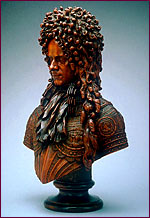 The
Menshikov Palace. The
Menshikov Palace.
In 1709, Peter I
presented Vasilyevsky Island to his favourite courtier and associate,
Alexander Menshikov (1673-1729). The son of the tsar's stableman,
Menshikov became a distinguished courtier and the first Governor-General
of St. Petersburg.
The palace of Prince Alexander Menshikov was founded
on Vasilevsky Island in 1710.
|
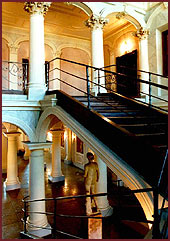 It
is the first stone building in St. Petersburg and one of the
oldest surviving buildings in the city. It
is the first stone building in St. Petersburg and one of the
oldest surviving buildings in the city.
The Menshikov Palace, had an unusually rich decor. The
palace interior strikes one with its splendour, especially its
carved wooden walls, the ceiling of painted leather and the
marvellous Dutch tiles.
Before Peterhof was built,
Peter held official functions and parties at Menshikov's place.
Eventually palace became the centre of the city's social and
political life where Peter's grand "assemblies" were
held, Russia's military victories were celebrated and foreign
guests received.
|
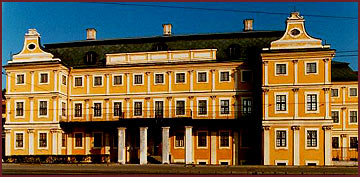
The Menshikov Palace. View from
the Neva River.
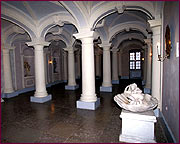 Aleksander
Menshikov was Peter I's closest pal. Catherine I, Peter's second
wife, was originally a serving girl working for Menshikov. Menshikov
knew how much Peter liked women, particularly other people's
women, and so despite their good friendship, he was reluctant
to show this particular serving girl to the tsar. However, Peter
was a crafty fellow, and he managed to swoop her away from Menshikov. Aleksander
Menshikov was Peter I's closest pal. Catherine I, Peter's second
wife, was originally a serving girl working for Menshikov. Menshikov
knew how much Peter liked women, particularly other people's
women, and so despite their good friendship, he was reluctant
to show this particular serving girl to the tsar. However, Peter
was a crafty fellow, and he managed to swoop her away from Menshikov.
The unique appearance of the building and its courtyard
took shape over the course of construction, which lasted many
years and involved European architects and artists.
The palace combines both traditionally Russian and new, imported,
methods and forms, incorporating all the latest achievements
in construction and art of the era.
|
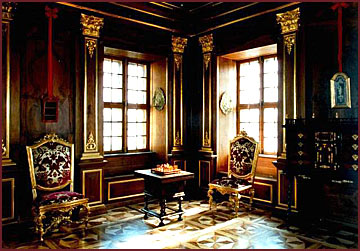 |
The
Menshikov Palace. Walnut Study.
|
|
After more than twenty years of painstaking restoration
work, the Menshikov Palace became a branch of the State Hermitage
Museum in 1981, featuring permanent exhibition on "Russia's
Culture of the First Third of the 18th century". As part
of the Hermitage Museum, the Menshikov Palace was able to draw
on the Museum's large collections incorporating not only former
imperial property but also the property of the Russian nobility,
including objects confiscated from Prince Menshikov. |
|


